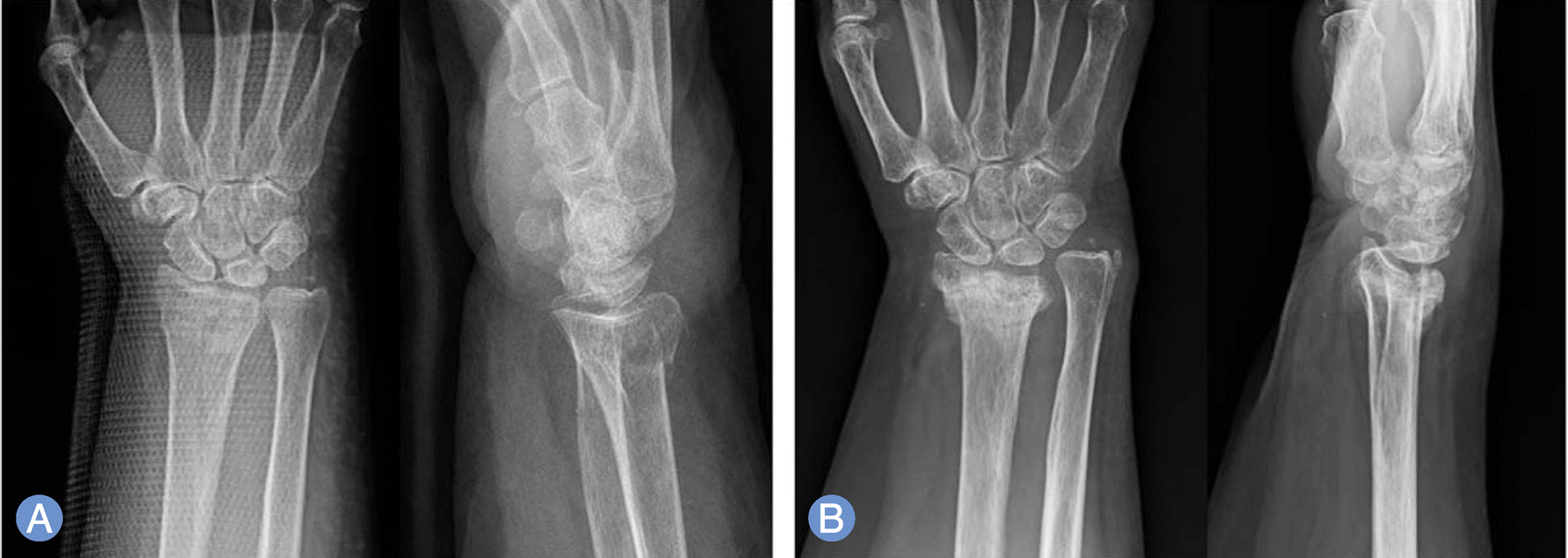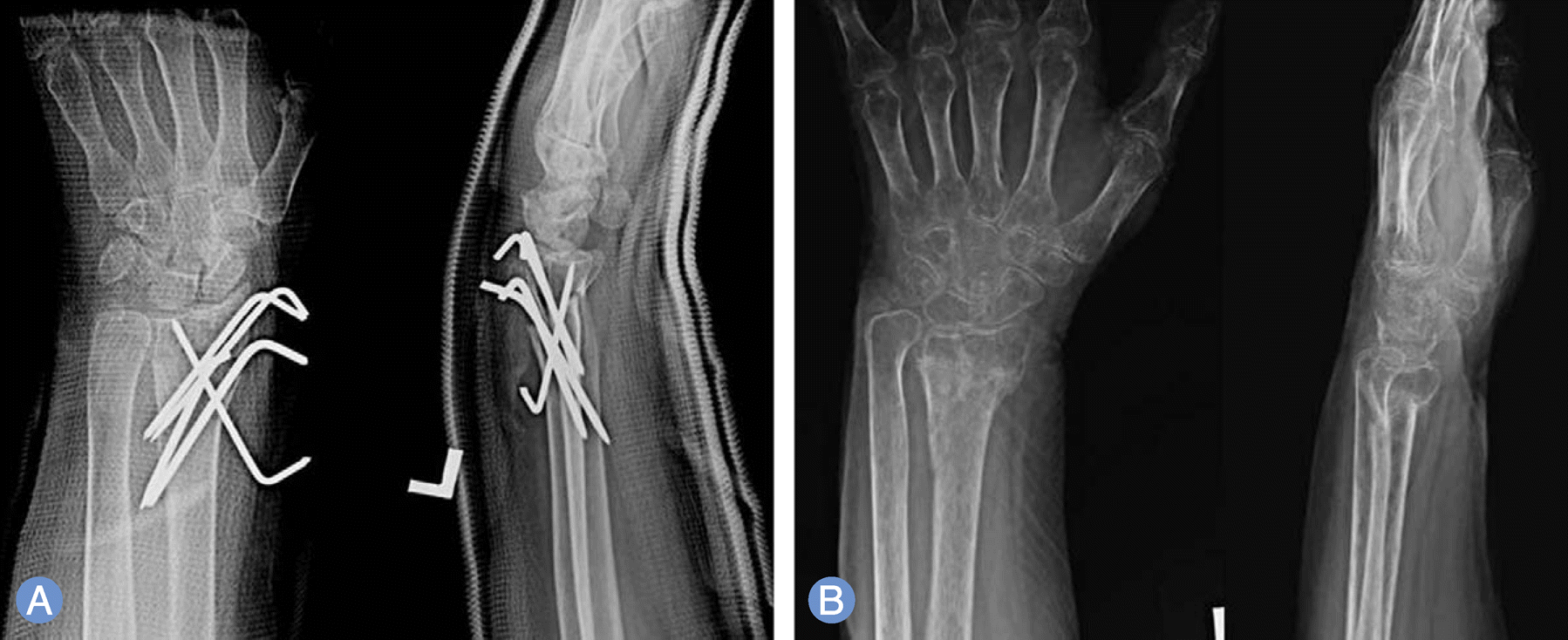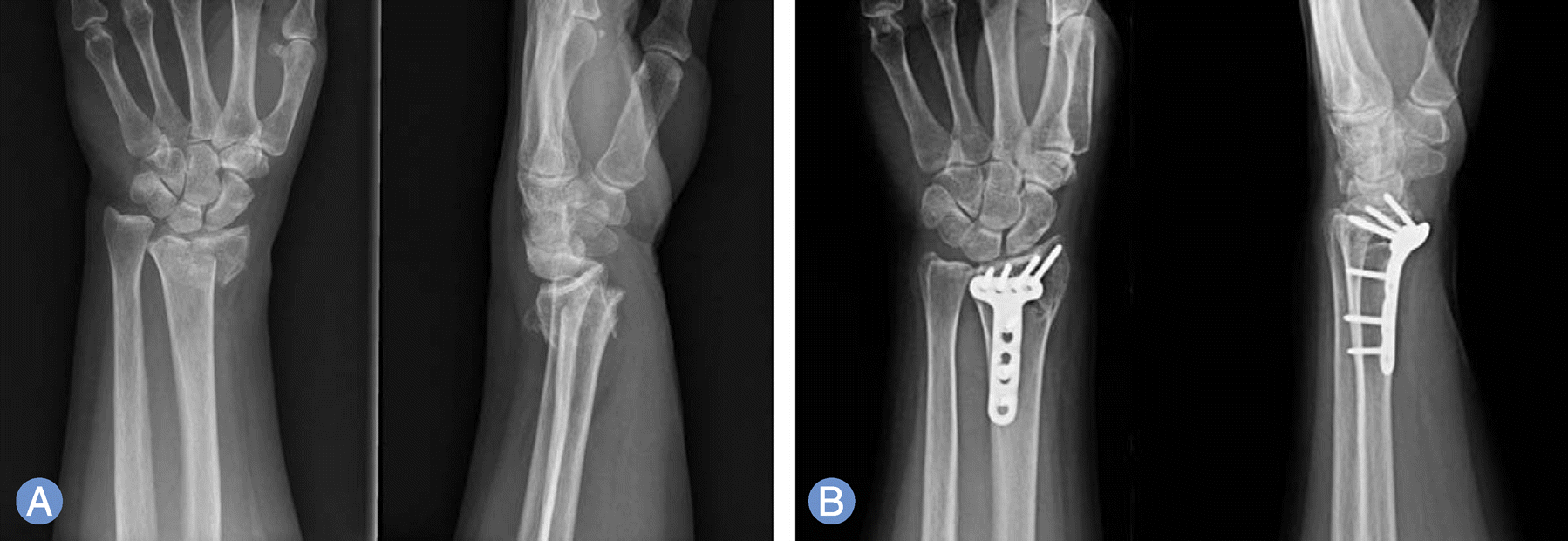Abstract
Distal radius fractures are one of the most common types of fractures in the elderly. It is well documented that increased risk of a distal radius fracture in older patients is associated with decreased bone mineral density. Also, low bone mineral density increased severity of fracture and instability of fracture after reduction. Fracture displacement in the elderly does not necessarily result in functional impairment. Therefore, conservative treatment has been a mainstay treatment even in unstable fracture in the elderly. However, there is an increasing trend toward operative treatment recently, because functional demand increased in the elderly due to active life style and volar locking plate fixation enables the elderly early return to daily activity even in osteoporotic distal radius fracture.
Go to : 
REFERENCES
1. Baron JA, Karagas M, Barrett J, et al. Basic epidemiology of fractures of the upper and lower limb among Americans over 65 years of age. Epidemiology. 1996; 7:612–8.

2. Cummings SR, Kelsey JL, Nevitt MC, O'Dowd KJ. Epidemiology of osteoporosis and osteoporotic fractures. Epidemiol Rev. 1985; 7:178–208.

3. Nellans KW, Kowalski E, Chung KC. The epidemiology of distal radius fractures. Hand Clin. 2012; 28:113–25.

4. Stein EM, Liu XS, Nickolas TL, et al. Abnormal microarchitecture and reduced stiffness at the radius and tibia in postmenopausal women with fractures. J Bone Miner Res. 2010; 25:2572–81.

5. Earnshaw SA, Cawte SA, Worley A, Hosking DJ. Colles’ fracture of the wrist as an indicator of underlying osteoporosis in postmenopausal women: a prospective study of bone mineral density and bone turnover rate. Osteoporos Int. 1998; 8:53–60.

6. Hegeman JH, Oskam J, van der Palen J, Ten Duis HJ, Vierhout PA. The distal radial fracture in elderly women and the bone mineral density of the lumbar spine and hip. J Hand Surg Br. 2004; 29:473–6.

7. Kanterewicz E, Yanez A, Perez-Pons A, Codony I, Del Rio L, Diez-Perez A. Association between Colles’ fracture and low bone mass: age-based differences in postmenopausal women. Osteoporos Int. 2002; 13:824–8.

8. Oyen J, Brudvik C, Gjesdal CG, Tell GS, Lie SA, Hove LM. Osteoporosis as a risk factor for distal radial fractures: a case-control study. J Bone Joint Surg Am. 2011; 93:348–56.
9. Oyen J, Rohde G, Hochberg M, Johnsen V, Haugeberg G. Low bone mineral density is a significant risk factor for low-energy distal radius fractures in middle-aged and elderly men: a case-control study. BMC Musculoskelet Disord. 2011; 12:67.

10. Rozental TD, Deschamps LN, Taylor A, et al. Premenopausal women with a distal radial fracture have deteriorated trabecular bone density and morphology compared with controls without a fracture. J Bone Joint Surg Am. 2013; 95:633–42.

11. Dias JJ, Wray CC, Jones JM. Osteoporosis and Colles’ fractures in the elderly. J Hand Surg Br. 1987; 12:57–9.

12. Xie X, Barenholdt O. Bone density and geometric properties of the distal radius in displaced and undisplaced Colles’ fractures: quantitative CT in 70 women. Acta Orthop Scand. 2001; 72:62–6.

13. Sakai A, Oshige T, Zenke Y, Suzuki M, Yamanaka Y, Nakamura T. Association of bone mineral density with deformity of the distal radius in low-energy Colles’ fractures in Japanese women above 50 years of age. J Hand Surg Am. 2008; 33:820–6.

14. Mackenney PJ, McQueen MM, Elton R. Prediction of instability in distal radial fractures. J Bone Joint Surg Am. 2006; 88:1944–51.

15. Clayton RA, Gaston MS, Ralston SH, Court-Brown CM, McQueen MM. Association between decreased bone mineral density and severity of distal radial fractures. J Bone Joint Surg Am. 2009; 91:613–9.

16. Biyani A, Simison AJ, Klenerman L. Fractures of the distal radius and ulna. J Hand Surg Br. 1995; 20:357–64.

17. Ruchelsman DE, Raskin KB, Rettig ME. Outcome following acute primary distal ulna resection for comminuted distal ulna fractures at the time of operative fixation of unstable fractures of the distal radius. Hand (N Y). 2009; 4:391–6.

18. Gartland JJ Jr, Werley CW. Evaluation of healed Colles’ fractures. J Bone Joint Surg Am. 1951; 33:895–907.

19. McQueen M, Caspers J. Colles fracture: does the anatomical result affect the final function? J Bone Joint Surg Br. 1988; 70:649–51.

20. Anzarut A, Johnson JA, Rowe BH, Lambert RG, Blitz S, Majumdar SR. Radiologic and patient-reported functional outcomes in an elderly cohort with conservatively treated distal radius fractures. J Hand Surg Am. 2004; 29:1121–7.

21. Azzopardi T, Ehrendorfer S, Coulton T, Abela M. Unstable extra-articular fractures of the distal radius: a prospective, randomised study of immobilisation in a cast versus supplementary percutaneous pinning. J Bone Joint Surg Br. 2005; 87:837–40.
22. Grewal R, MacDermid JC. The risk of adverse outcomes in extra-articular distal radius fractures is increased with malalignment in patients of all ages but mitigated in older patients. J Hand Surg Am. 2007; 32:962–70.

23. Roumen RM, Hesp WL, Bruggink ED. Unstable Colles’ fractures in elderly patients. A randomised trial of external fixation for redisplacement. J Bone Joint Surg Br. 1991; 73:307–11.

24. Synn AJ, Makhni EC, Makhni MC, Rozental TD, Day CS. Distal radius fractures in older patients: is anatomic reduction necessary? Clin Orthop Relat Res. 2009; 467:1612–20.

25. Board T, Kocialkowski A, Andrew G. Does Kapandji wiring help in older patients? A retrospective comparative review of displaced intra-articular distal radial fractures in patients over 55 years. Injury. 1999; 30:663–9.

26. Young BT, Rayan GM. Outcome following nonoperative treatment of displaced distal radius fractures in low-demand patients older than 60 years. J Hand Surg Am. 2000; 25:19–28.

27. Beumer A, McQueen MM. Fractures of the distal radius in low-demand elderly patients: closed reduction of no value in 53 of 60 wrists. Acta Orthop Scand. 2003; 74:98–100.

28. Handoll HH, Madhok R. Conservative interventions for treating distal radial fractures in adults. Cochrane Database Syst Rev. 2003; (2):CD000314.

29. Blakeney WG. Stabilization and treatment of Colles’ fractures in elderly patients. Clin Interv Aging. 2010; 5:337–44.
30. Simic PM, Weiland AJ. Fractures of the distal aspect of the radius: changes in treatment over the past two decades. Instr Course Lect. 2003; 52:185–95.
31. Lenoble E, Dumontier C, Goutallier D, Apoil A. Fracture of the distal radius: a prospective comparison between trans-styloid and Kapandji fixations. J Bone Joint Surg Br. 1995; 77:562–7.

32. Mah ET, Atkinson RN. Percutaneous Kirschner wire stabilisation following closed reduction of Colles’ fractures. J Hand Surg Br. 1992; 17:55–62.

33. Hegeman JH, Oskam J, Vierhout PA, Ten Duis HJ. External fixation for unstable intra-articular distal radial fractures in women older than 55 years. Acceptable functional end results in the majority of the patients despite significant secondary displacement. Injury. 2005; 36:339–44.
34. Aktekin CN, Altay M, Gursoy Z, Aktekin LA, Ozturk AM, Tabak AY. Comparison between external fixation and cast treatment in the management of distal radius fractures in patients aged 65 years and older. J Hand Surg Am. 2010; 35:736–42.

35. Orbay JL, Fernandez DL. Volar fixed-angle plate fixation for unstable distal radius fractures in the elderly patient. J Hand Surg Am. 2004; 29:96–102.

36. Chung KC, Shauver MJ, Birkmeyer JD. Trends in the United States in the treatment of distal radial fractures in the elderly. J Bone Joint Surg Am. 2009; 91:1868–73.

37. Beharrie AW, Beredjiklian PK, Bozentka DJ. Functional outcomes after open reduction and internal fixation for treatment of displaced distal radius fractures in patients over 60 years of age. J Orthop Trauma. 2004; 18:680–6.

38. Chung KC, Squitieri L, Kim HM. Comparative outcomes study using the volar locking plating system for distal radius fractures in both young adults and adults older than 60 years. J Hand Surg Am. 2008; 33:809–19.

39. Kim JK, Koh YD, Kook SH. Effect of calcium phosphate bone cement augmentation on volar plate fixation of unstable distal radial fractures in the elderly. J Bone Joint Surg Am. 2011; 93:609–14.

Go to : 
 | Fig. 1.A 74-year-old female patient was conservatively treated for unstable distal radius fracture due to several comorbidities including angina and asthma. (A) The distal radius fracture is relatively well reduced after initial closed reduction. (B) The radiographs demonstrates severe radial shortening and dorsal angulation at the time of cast removal, however, she satisfied her final outcome. |
 | Fig. 2.A 76-year-old female patient was treated with percutaenous K-wire fixation using Kapandji technique for unstable distal radius fracture. (A) The distal radius fracture is relatively well reduced after initial fixation. (B) However, the radiographs at 6 months postoperatively shows about 4 mm radial shortening. |
 | Fig. 3.A 68-year-old female patient was treated with volar locking plate fixation technique for unstable distal radius fracture. (A) The fracture is unstable because several dorsal angulation and dorsal communition are notified in initial radiographs. (B) The reduction is maintained until fracture is consolidation through volar locking plate fixation. |




 PDF
PDF ePub
ePub Citation
Citation Print
Print


 XML Download
XML Download